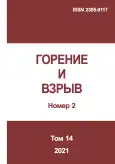Entialpy of formation and energy reorganization of naphthalene radicals
- Autores: Miroshnichenko E.A.1, Kon’kova T.S.1, Matyushin Y.N.1, Vorob’ev A.B.1, Inozemtsev J.O.1, Inozemtsev A.V.1
-
Afiliações:
- N. N. Semenov Federal Research Center for Chemical Physics of the Russian Academy of Sciences
- Edição: Volume 14, Nº 2 (2021)
- Páginas: 100-105
- Seção: Articles
- URL: https://ogarev-online.ru/2305-9117/article/view/292381
- DOI: https://doi.org/10.30826/CE21140211
- ID: 292381
Citar
Resumo
Based on the method of double-difference, the enthalpy of formation of radicals of naphth-1-yl and naphth-2-yl ( kJ/mol) has been calculated. As objects of study, data on the enthalpies of formation of naphthalene derivatives were used and as the reference values, the phenyl radical and benzene derivatives have been applied. The obtained data on the enthalpies of formation of radicals of naphth-1-yl and naphth-2-yl were applied to adjust the existing enthalpies of formation of naphthalene derivatives in the gas phase. For 1- and 2-nitronafthalines, the same value was obtained equal to 133 kJ/mol. The literature data were and kJ/mol for 1-nitronaftaline and 129.8 kJ/mol for 2-nitronaftaline (calculation). The data obtained allowed calculating the dissociation of bonds in 1- and 2-nitronaftaline which was kJ/mol and close to the energy of this bond in benzene ( kJ/mol). To determine the identity of bonds in naphthalene and benzene, a joint calculation of C–N and C–C bonds in naphthalene and benzene from the enthalpy of atomization of these compounds was performed. The energies of bonds are obtained identical, i. e., the values are the same which means that the energies of the rearrangement of radicals naphth-1-yl and naphth-2-yl are equal to 0 kJ/mol.
Sobre autores
E. Miroshnichenko
N. N. Semenov Federal Research Center for Chemical Physics of the Russian Academy of Sciences
Autor responsável pela correspondência
Email: eamir02@mail.ru
Doctor of Science in chemistry, chief research scientist
RússiaT. Kon’kova
N. N. Semenov Federal Research Center for Chemical Physics of the Russian Academy of Sciences
Email: taskon@mail.ru
Doctor of Science in chemistry, chief research scientist
RússiaYu. Matyushin
N. N. Semenov Federal Research Center for Chemical Physics of the Russian Academy of Sciences
Email: ynm07@mail.ru
Doctor of Science in technology, head of laboratory
RússiaA. Vorob’ev
N. N. Semenov Federal Research Center for Chemical Physics of the Russian Academy of Sciences
Email: ynm07@mail.ru
Candidate of Science in technology, senior research scientist
RússiaJa. Inozemtsev
N. N. Semenov Federal Research Center for Chemical Physics of the Russian Academy of Sciences
Email: vectr1@yandex.ru
senior research scientist
RússiaA. Inozemtsev
N. N. Semenov Federal Research Center for Chemical Physics of the Russian Academy of Sciences
Email: vectr1@yandex.ru
research scientist
RússiaBibliografia
- Orlov, Y. D., Y. A. Lebedev, and I. S. Saifullin. 2001. Termokhimiya organicheskikh svobodnykh radikalov [Thermochemistry of organic free radicals]. Moscow: Nauka. 304 p.
- Luo, Y. 2007. Comprehensive handbook of chemical bond energies. Boca Raton – London – New York: CRC Press. 1655 p. doi: 10.1201/9781420007282.
- Miroshnichenko, Е. А., T. S. Kon’kova, Yu. N. Matyushin, and А. А. Berlin. 2014. Enthalpy of formation of 3-methylfurazan-4-yl radical. Dokl. Phys. Chem. 456(2):94–96.
- Miroshnichenko, Е. А., Yu. D. Orlov, T. S. Kon’kova, Yu. N. Matyushin, and А. А. Berlin. 2015. Energy characteristics of chemical bonds and radical reorganizations. Dokl. Phys. Chem. 465(1):287–290.
- Miroshnichenko, Е. А., L. L. Pashchenko, T. S. Kon’kova, Yu. N. Matyushin, and А. А. Berlin. 2016. The enthalpies of formation and reorganization of aromatic radicals. Russ. Chem. B. 65:1977–1980.
- Miroshnichenko, Е. А., Yu. N. Matyushin, T. S. Kon’kova, Yu. D. Orlov, and А. А. Berlin. 2017. Rearrangement energies for radicals of azido nitroaromatic compounds. Dokl. Phys. Chem. 477(2):212–215.
- Miroshnichenko, E. A., T. S. Kon’kova, Yu. N. Matyushin, Yu. D. Orlov, L. L. Pashchenko, А. B. Vorob’ev, and A. V. Inozemtsev. 2019. Radical reorganization energies. Russ. J. Phys. Chem. B 13(2):225–230.
- Stevens, W. R., B. Ruscic, and T. Baer. 2010. Heats of formation of C6H5•, C6H5+ , and C6H5NO by threshold photoelectron photoion coincidence and active thermo-chemical tables analysis. J. Phys. Chem. A 13134–13145. doi: 10.1021/jp107561s.
- Pedley, J. B. 1994. Thermochemical data and structures of organic compounds. TRC data ser. College Station, TX: Thermodynamic Research Center Texas. Vol. 1. 807 p.
- Yagofarov, M. I., R. N. Nagrimanov, M. A. Ziganshin, and B. N. Solomonov. 2018. New aspects of relationship between the enthalpies of fusion of aromatic compounds at the melting temperatures and the enthalpies of solution in benzene at 298.15 K. Part I. J. Chem. Thermodyn. 116:152–158. doi: 10.1016/j.jct.2017.09.006.
- Nagrimanov, R. N., A.A. Samatov, A. V. Buzyurov, A. G. Kurshev, M. A. Ziganshin, D. H. Zaitsau, and B. N. Solomonov. 2018. Thermochemical properties of mono- and di-cyano-aromatic compounds at 298.15 K. Thermochim. Acta 668(10):152–158. doi: 10.1016/j.tca. 2018.07.026.
- Oleynik, B. N. 1973. Tochnaya kalorimetriya [Accurate calorimetry]. Moscow: Standardinform Publs. 208 p.
- Ribeiro da Silva Manuel, A. V., L. M. P. F. Amaral, A. F. L. O. M. Santos, amd J. R. B. Gomes. 2006. Thermochemistry of nitronaphthalenes and nitroanthracenes. J. Chem. Thermodyn. 38:748–755. doi: 10.1016/j.jct.2005.08.007.
- Suntsova, M. A., and O.V. Dorofeeva. 2016. Use of G4 theory for the assessment of inaccuracies in experimental enthalpies of formation of aromatic nitrocompounds. J. Chem. Eng. Data 1:313–329. doi: 10.1021/acs. jced.5b00558.
- Andreev, K. K. 1966. Termicheskoe razlozhenie i gorenie vzryvchatykh veshchestv [Thermal decomposition and combustion of explosives]. Moscow: Nauka. 346 p.
Arquivos suplementares









